 |
| Birthplace for Ports- Douro Valley. Vineyards of Quinta do Crasto |
Instituto dos Vinhos do Douro e Porto (IVDP) which defends and regulates the strictly framed rules of making Port since 1756, looks at the Port producing countries like the USA, UK, India, Australia and South Africa with disdain and has been making efforts to stop the illegal or the fraudulent (as they see it) production. IVDP has successfully negotiated with South Africa and Australia but when the move was thwarted by the USA, it made bi-lateral understanding with a few wine regions with a fair amount of success. Goa is on their radar but about that in a future article.
What is Port
Generally people find it easy to understand that Port is a fortified wine with slightly higher alcohol levels of maybe 19, 20 or 22 % and is made by adding neutral alcohol to it by stopping the natural fermentation at 8-9% to make it ‘strong’. That was the concept perhaps ushered in by the Portuguese over three centuries ago after they had discovered India and started making Port in Goa, even before their regulations came into existence. But that is where the similarity and comprehension usually ends.
Port is fortified wine made in the specified geographic limitation in Douro and Port, North and North-eastern port of Portugal, made from local grapes and aged in different styles according to the regulations. Interestingly Porto or Oporto (as the British shippers started named after ‘O Porto’ which means the city of Porto) as the name has stuck even today, has nothing to do with Port making-except that the offices of all Port shippers used to be in this town from seventeenth century onwards and by law Port had to be shipped from Porto (till 1986). The customs used to collect the export duty here as the wine was shipped to the UK and Netherlands on boats from river Douro and Atlantic Ocean. Warehousing and ageing was done across river Douro in Vila Nova de Gaia on the other side. Even today, most shippers and producers have storage facilities in Gaia.
Portly and Port Styles
While the image of Portly Brits might be a figment of imagination, the usually high content in sugar makes it important to understand the possible addition to the girth. It is equally important to appreciate the styles and varieties of Ports that confuse even the Portuguese or even the ‘Portese’. There are different styles based on quality of grapes (vineyards are classified as A to E), the ageing period and whether it is aged in a big Vat, Cask or bottle.
Commonly used styles are Ruby Red, White, Rosé (you might not find them described in wine books as they are a relatively new on the scene) in terms of colour and mainly Tawny (with different average ages of maturation), LBV (late bottle vintage), Colheita and Vintage ports as styles based on ageing process and time.
 |
| Ruby Port from Rozés- served in the special Port Glass |
Ruby: The basic port after aging a 2-3 years, its sweet and fruity style (Goan ‘Ports’ try to copy this style.) Slightly raw and rough on the edges on the palate, it does not improve with age. Super-markets and the French thrive on it as it is a very desirable condiment in their cooking. Usually blended from other years too (Port producers don’t like to use the term vintage as it is reserved exclusively for the Vintage Port). Extra couple of years in the wood gives it the privilege of being termed as a Reserve port. The cheaper versions are aged in the stainless steel tanks though oak vats are also used- the objective being to keep the fruitiness and presence of cherries and strawberries while making it slightly smooth on the palate.
Tawny: The port may be set aside to age in small oak casks of 550 liters when it gradually loses its original deep purple colour and takes on an amber hue known as tawny. The nose and palate get more complex and elegant with time. The fruitiness is gradually replaced with flavours of wood ageing like vanilla and caramel, with nose becoming distinctly spicy.
Tawny ports are bottled from blends of different years and are further categorized as 10,20,30 and 40 years (average) tawny ports, 10 years signifying that the average age of the blend is more than 10 years but less than 20. Interestingly, the colour becomes lighter until 30 years when it starts becoming a shade darker though with olive green hue. Naturally the older the age of the tawny, more expensive the port-20-30 year old tawny usually gives the best bang for the buck.
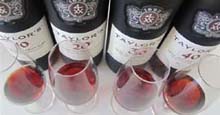 |
| Aged Tawny Ports from Taylor's |
Aged Tawny is the most versatile of Ports, with rich and opulent but mellow flavours making them an ideal choice as dessert wines or as a wine to give a perfect and leisurely finish to any special meal. They may be served cool and are an excellent choice for summer. That is not the only reason why they would make an ideal choice for India. The open bottle, if stored properly can last a few weeks or even months, so one does not have to worry about finishing it overnight.
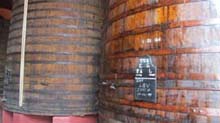 |
| Ageing of an LBV 2007 at Churchill Graham |
Late Bottle Vintage (LBV): The credit for introducing LBV is claimed by Taylor Fladgate, one of the oldest and well known producers of pedigreed Ports like Taylor’s, Fonseca, Croft and now Cockburn, as an alternative when the Vintage year is not declared. Port from a particular harvest is left in the cask for 2 years for the winemaker to decide if it would make a good Vintage Port. In that case it would be, subject to the approval of the regulator body IVDP, bottled and laid aside for ageing in the bottle. Otherwise, it may be left to age for 4-6 years (by law) in the cask and then filtered, bottled and sold with the date of bottling mentioned. A filtered LBV does not improve with age and is ready to drink. However, some bottlers may bottled it unfiltered (in which case it is mentioned on the label) and then it may improve in the bottle for a few years like the Vintage Port.
Vintage: Vintage Port is the ultimate for any Port- these are often the investment grade Ports that last and last forever. Traditionally, during exceptionally good years- on an average three in a decade, when the winemaker and a tasting panel feels that the wine is worthy of ageing for decades, they may declare it a Vintage year and select a small quantity to be sold as Vintage Port. The samples have to be submitted to the IVDP and they certify for each producer individually whether it may be declared as such. It is not necessary for the producer to declare it a Vintage even if the regulator certifies as such and each producer declares its own Vintage. For instance Croft, Fonseca and Taylor’s have recently announced 2009 as a Vintage year- 2000, 2003 and 2007 were already declared Vintage years. These universal vintage years apart, 1980, 1985, 1991, 1994 and 1997 were the universally declared Port Vintages during the previous two decades.
 |
| Vintage Ports- 2003 at the IVDP Port wine shop |
It is interesting that although the value of a Vintage Port goes up consistently, after initial appreciation of even up to 200-300% after the release and Vintage Ports of over 100 years and even older are not uncommon and fetch exorbitant prices, it may be consumed and enjoyed even after a few years, preferably a decade-for instance Taylor’s 2001 is already drinking well. Vintage Port should be treated as a still wine for consumption and the bottle must be finished within a day or two, like any other fine wine. Therefore, if one orders it in a restaurant or opens it in the house, one must empty the bottled- that’s why one finds half bottles (375 mL) are common for Vintage Ports.
Each vineyard or farm is named as a Quinta in Porto and Douro. When Vintage Port is made from wines from different Quintas, it is classified as the house Vintage, like Taylor’s Vintage Port but when it is made exclusive from a single vineyard or quinta, name of the vineyard may be mentioned on the bottle. For instance, Quinta de Vargellas from Taylor’s commands a lot of respect. Usually, Quinta Vintages are aged at the warehouses in Gaia, for 8-10 years before releasing them in the market.
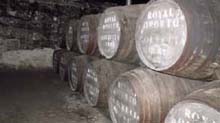 |
| Colheitas from Real Companhia Velha-oldest is 1867 |
Colheita: Port may also be made from grapes of a single harvest and kept in old vats for 7 years and above when it gets tawny-like properties and becomes silky and smooth. It may be sold as such or used to make a tawny. Although they may age for 30-50 years, 100 years or more is not unheard of. I had the opportunity to taste 5 different vintages, the oldest being 1867 from Real Companhia Velha. It was still delicious, caramelized flavoured with a sliver of orange rind in the background and was doing rock n roll on my palate. The winery also uses a fraction of it to bottle special tawny Ports like it did in 2006 to celebrate the 250th anniversary of the starting of the company.
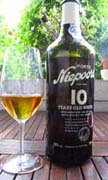 |
| A 10 Year Old White port from Niepoort Vinhos |
White: Generally, an off-dry style used as an aperitif with Foie gras or even Indian spicy starters, one sees drier styles occasionally. Made by the same process as a tawny-in the oak casks, this wine offers wide spectrum of choices with colours ranging from pale to golden and the flavours changing from very dry to very sweet (called Lagrima- teardrops in Portuguese because of the dense viscosity). A chilled glass of Churchill's 10 year old Dry Apéritif White Port from Churchill Grahams is a good example of the perfect drink before lunch or dinner, especially during summers, to build up appetite. I had
the privilege of sharing some dark brown coloured delicious white Port with Dirk Niepoort of Niepoort Vinhos -that had been in his cellar since 1955!
White Port also makes a delicious cocktail called Portonic, using tonic water, lime juice and mint leaves, with plenty of ice cubes; it was not surprising to see its popularity at the Gala Dinner held on the culmination of OIV International Conference of Vine and Wine.
Rosé Port : A relative new entrant in the world of Ports, this could reflect the growing popularity of Rose wines during the last couple of decades. The older Port houses and serious Port drinkers still snigger at the concept but a few producers have added it to their portfolio. The pink salmon coloured wine is produced by a light and short maceration
of red grapes without any oxidation during the preservation. Very aromatic and light on the palate, these wines are easier to drink as I found with a Croft Rose Port, when I had it with lunch at the restaurant with a view, adjacent to the warehouse and owned by the Taylor Fladgate and a popular eating place for locals and tourists alike.
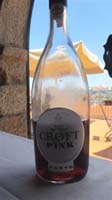 |
| Rose Port from Croft |
Grape Varieties used in Port
Although several autochthonous (indigenous) grapes have been authorized by the IVDP- for making port, about 30 varieties are used although Quinta do Crasto has a wine using field blends which has already shown about 48 varietals as evidenced by analyzing the DNA of vines. However, the basic and most common used grape is Touriga Nacional, the signature dense and fruity grape of Portugal. This low yielding grape has strong tannins and offers great complexity and age-worthiness of the Port wine. Other popular varietals are the full-bodied Touriga Francesa, firm and fine Tinta Roriz (Tempranillio) and the rich and fragrant Tinta Barroca and Tinta Amarela.
A host of local white grapes like Rabigato, Malvasia, Fina, Viosinho and several other grapes difficult-to-pronounce, make up the majority in the white Port blends.
 |
| Lagares of Quinta do Crasto with semi-automatic plungers |
Lagares to make Port
It is important to mention this aspect of grape crushing which is considered primitive by most other countries but still in vogue for top end Ports. it may be a popular gimmick to draw people to wine festivals in India and sometimes oversees, with a few cut up barrels full of some grapes with a few pretty models or celebrities lifting their skirts up or rolled over pants and stomping the grapes, but the process is still used to crush grapes with human feet in open granite tanks called lagares. Groups of men and women generally work in 2-hour shifts with co-ordinated movements to tread the grapes in order to keep the skins in constant touch with the fermenting juice in order to extract the flavours, tannins and colour in the shorter time available as the fermentation has to be stopped when it reaches the level of 8-9% at which point the neutral and colour-less 77% ethyl alcohol is mixed to stop the fermentation, bringing the level up to 19-22% as required by law.
 |
| One of the Lagares at Quinta do Seixo of Sogrape with Robots
to stomp grapes |
In case you wonder about the hygiene aspect of the process, the producers take pains to inform that the feet are washed with brandy before the people jump in and the depth of the fermenting juice is rarely more than 22 cms. Different producers including Quinta do Seixo belonging to the biggest wine producer of Portugal- Sogrape and Quinta do Crasto that I visited, have designed their own versions of Robots that do the job of treading more efficiently and possibly more hygienically.
Serving and Storage of wines
To enjoy Port wines the best, they need to be served at the right temperature; like still wines. White Port should be served chilled at 6-12 ˚C with older Ports at the higher end of the spectrum. Unlike still wine, It is not considered bad etiquette to put some ice cubes if the taste or the temperature outside demands it. Rose should be served between 10-12˚C. Tawny Ports should be served cool from 12-16˚C- 40 year olds at higher end of the temperature spectrum. Ports and Vintages should be served at 16-18˚C. LBV should be served cool at around 14-16˚C.
For storage, look at the closure-if it is a cork stopper, bottle should be laid up vertically at 13-16˚C and may be consumed even up to a couple of months or more (some say they keep for even 6 months) making then a natural choice for India . If it is a traditional cork closure, the bottled should be laid horizontally at the same temperature and must be finished the same day or within a couple of days.
So pick up a bottle or two of Port wine next time you possibly can-according to your taste and enjoy each serving of 60-90 mL, and you will surely love the white Port as a cocktail
Subhash Arora
The above article and the ones that follow in the future editions of delWine, have been based on discussions with several producers and visits in Porto and Douro from June 17-25 to several wineries and warehouse, organized by the IVDP before and during the OIV International Vine and Wine Conference held at Porto- editor.
|